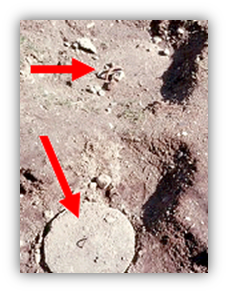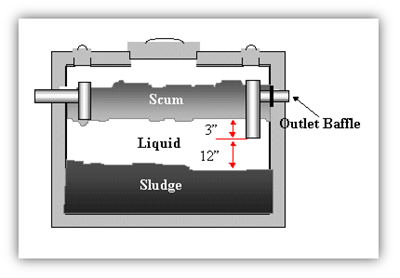About septic systems
Learn why maintaining your septic system is important for your health and the health of the community.

Arrows pointing to on-site sewage/septic system lids in the ground.
How do I know where my on-site sewage/septic system is?
There may be access covers for your septic tank exposed in your yard (see photo). If you can’t find the access covers, you can:
- Search and download a property's as-built drawings. As built drawings are the drawings submitted to Public Health - Seattle & King County in order to get a building permit. These drawings show where the system is.
- If you cannot find the record online, contact King County Septic at 206-477-8050 and ask for a copy of the "as built" drawings for your property.
Tips to save water and maintain your septic system
Household chemicals
Don't pour household chemicals or medication down the drain.
Chemicals destroy bacteria in your system that are necessary to break down solids.
Call the Public Health Hazardous Waste Line at 206-296-4692 to ask about chemical disposal.
Long-term use of medications, such as antibiotics, may also destroy important bacteria in your septic tank and drainfield. Visit the Washington State Medicine Disposal Program site for safe disposal of unwanted medications.
Don't use septic tank additives.
These products may be harmful by adding extra solids to the system that can clog your drainfield. The chemicals can also pollute groundwater and surface water. If you feel you must use additives, be sure to use only those that have received written approval from the Washington State Department of Health. It is unlawful to use any non-approved additive.
Don't drain water from hot tubs into your septic system.
Large volumes of water can 'drown' your drainfield, and chlorine can destroy important bacteria in your septic tank and drainfield. Drain hot tubs away from the system, especially the drainfield.
For disposal options, call King County's Water and Land Resources Division at 206-477-4800 or email them at WLRCustomerService@kingcounty.gov.
Bathroom
Did you know that residences use the most water for flushing toilets? Each person flushes 18.5 gallons per day!* Toilets, showers, and faucets represent more than 70% of indoor water use.
You can lower your water use in the bathroom by following these easy tips:
- Repair leaky faucets and toilets. Slow leaks, such as a dripping faucet, can generate 15 to 20 gallons (57 to 76 liters) of wastewater per day.*
- Use "low flow" fixtures on faucets and shower heads (available at most hardware stores)
- Faucet insert: slows water flow
- Faucet aerator: adds air to spread water flow
- Reduced flow faucet: faucet built for low water flow
- Mixing valves: one fixture that regulates hot and cold water
- Take shorter showers.
- Turn off water while brushing teeth or shaving. Fill your sink halfway with water to rinse your razor.
Flush only bodily wastes and toilet paper down the toilet. Products labeled as "flushable" may not be suitable for a septic system.

Think before you flush
It's important to keep a careful eye on actions that may affect your sewer or septic system.
Download flyers to learn more:
Kitchen
Helpful tips to save water in the kitchen:
- Run only full loads in the dishwasher.
- Don't run the dishwasher and washing machine at the same time.
- Keep water in the refrigerator to avoid running water until it gets cold.
- Don't run the water while washing dishes.
- Rinse fruits and vegetables through a colander into a bowl, then use leftover water to water your houseplants.
- Keep faucets tightly closed.
- Use 'low flow' fixtures on faucets.
- Fix leaky faucets.
Laundry
Helpful tips to save water in the laundry room:
- Use the load size setting and proper water temperature.
- Run full loads in the washing machine.
- Don't run the dishwasher and washing machine at the same time.
- Consider a water efficient washing machine.
Does it matter what kind of laundry soap I use?
Current research indicates that it doesn't matter which you use, powder or liquid. What matters:
- How much detergent you use per load.
- How often you wash clothes or dishes.
An important way to maintain your system is to do loads of wash over several days rather than all in one day. Use the dishwasher sparingly, too.
Remember: the system works best when wastewater has time to separate, and the bacteria have time to break down the organic matter. Too much water going into the system too often rushes water through the system too fast.

Single compartment septic tank anatomy
When to pump your septic tank
Septic tanks usually need to be pumped every 3 to 5 years, depending on the amount of water use. Generally, septic tanks fill faster as more people use the septic system. This means more frequent pumping will be needed with larger households.
During your maintenance inspection, the maintainer can measure the scum and sludge layer in your tank to determine how often you need to pump your tank.
The septic tank should be pumped when the bottom of the scum layer is within 3 inches of the bottom of the outlet baffle or the top of the sludge layer is within 12 inches of the bottom of the outlet fitting.
What happens when it rains - is my drainfield compromised?
The drainfield is compromised when it is saturated, and the "effluent" (wastewater) doesn't have 2 to 3 feet to trickle down through. This can cause a public health hazard.
Current regulations prevent building drainfields where soils might become saturated. So, your drainfield should work well year-round unless:
- It is very old.
- The site of the drainfield has changed (caused by extensive landscaping changes, increased building around you).
- You use more water than the system is designed for.

 Translate
Translate